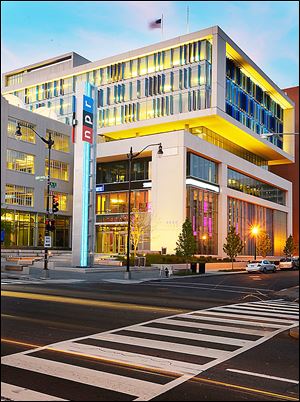
NPR’s new headquarters refuels funding debate
Critics grumble that edifice is far too lavish
6/22/2013
National Public Radio's new headquarters on North Capitol Street in Washington has drawn criticism from those who see it as far too luxe for a nonprofit news organization that depends partly on taxpayer support.
WASHINGTON — NPR’s gleaming new headquarters building in the shadow of the Capitol in Washington has soaring ceilings, a 24-hour “wellness” center, an employee gym, and a gourmet cafe staffed by a resident chef.
This, as it turns out, could be a political problem.
Open since April, NPR showed off the 400,000-square-foot complex to members of the media last week.
It immediately began drawing some grumbles from those who see the edifice as far too luxe for a nonprofit radio and digital-news organization that depends, in part, on taxpayer support. In effect, the building briefly became a new club with which to beat NPR over an old issue: whether public radio and television should be subsidized with federal and state funds.
The rumblings began after the widely read Drudge Report linked to a rather innocuous account of the news-media tour from the Web site FishBowlDC, which described the building’s features.
Soon, the blog and Twitter-ospheres were percolating with denunciations of the building’s cost and alleged excesses.
“They build a ‘News Palace’ and they still need taxpayer dollars?!?” tweeted Jim Farley, vice president of news for WTOP, the all-news radio station in Washington.
A blogger known as the Lonely Conservative sniped, “Who wouldn’t be jealous of working in such a lavish space, especially when one’s tax dollars help to fund” it?
And Michael Savage, the fire-breathing conservative radio host, took to his microphone to rail against the “incomprehensible” nature of NPR’s new digs.
“They just opened a new building, NPR,” sneered Mr. Savage on his syndicated show ... You will not believe the edifice they built for themselves. It’s astounding. You cannot believe what they gave themselves at NPR. ... How much money did that cost to build?”
Answer: $201 million, or a bit more than NPR’s annual operating budget of $174.7 million in fiscal 2013.
But is that excessive? In NPR’s view, the new building on North Capitol Street is both efficient and cost-effective, particularly compared to its former headquarters a few blocks west on Massachusetts Avenue. NPR, with 840 employees, said it had outgrown the old building, which was increasingly decrepit and costly to maintain.
The building is now being torn down.
“The reality is, we had to move,” said Emma Carrasco, NPR’s chief marketing officer, in an interview. “When we looked at the possibility of retrofitting our existing buildings and consolidating [into the old headquarters], it really wasn’t feasible. So building a cost-effective building was the most prudent decision for us. We based it on pure economics and our staffing and technological needs.”
What’s more, NPR officials point out, the new headquarters wasn’t financed with tax dollars, at least not directly. The organization raised funds through a combination of tax-free bonds, individual donations, and the proceeds from the sale of its old building.
The money raised for the building is separate from NPR’s operating budget, which comes from station fees, corporate sponsorships, and individual donations. Less than 2 percent of NPR’s operating budget comes from federal taxes.
But federal support is critical to public radio and NPR because it subsidizes hundreds of public stations, which then pay fees to NPR for its programs. The federal government provided $69.3 million in operating funds to public radio stations this year.
Republicans have sought to cut or eliminate public broadcasting’s subsidy periodically since the mid-1990s but have not succeeded.
Over at NPR’s headquarters, meanwhile, employees seem pleased to be in a spacious new work space. NPR legend Susan Stamberg, whose recorded voice announces the floors in NPR’s elevators, remembers the threadbare days of NPR in the early 1970s.
Back then, NPR was so bereft of production facilities or even office furniture that reporters used to sit on the floor to edit tape of interviews, she recalls.